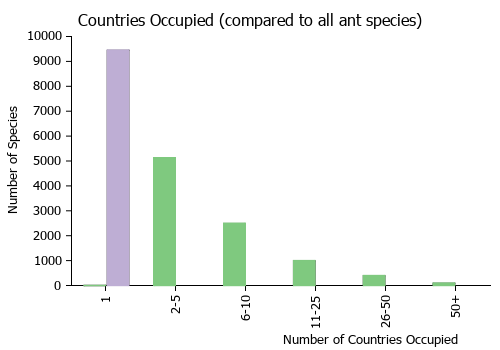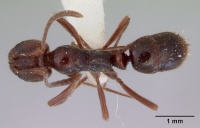Austroponera castanea
| Austroponera castanea | |
|---|---|

| |
| Scientific classification | |
| Kingdom: | Animalia |
| Phylum: | Arthropoda |
| Class: | Insecta |
| Order: | Hymenoptera |
| Family: | Formicidae |
| Subfamily: | Ponerinae |
| Tribe: | Ponerini |
| Genus: | Austroponera |
| Species: | A. castanea |
| Binomial name | |
| Austroponera castanea (Mayr, 1865) | |
| Synonyms | |
| |
Members of the melanaria group in Australia and Melanesia tend to inhabit mostly the moist, shady forests, but M. castanea shows much wider ecological tolerance in New Zealand, where nests are made not only in the shady forest in rotten wood and leaf litter, but also under stones in open pastures, and even in the soil of vegetable gardens in the cities. Judging from the structure of the workers and females, and from the habits of the melanaria group forms that Wilson and I have seen in the field, I should think that M. castanea is a fast·moving and rather timid ant, though with a respectable sting. The colonies are small to medium in size. Males have been taken abroad in the Auckland district in January and March. (Brown 1958)
Identification
This species shows considerable variation across its range (but see Austroponera castaneicolor).
Distribution
M. castanea is a widespread and common species in the North Island and also is found around Nelson, at the northern tip of the South Island.
Latitudinal Distribution Pattern
Latitudinal Range: -35.255047° to -41.3°.
| North Temperate |
North Subtropical |
Tropical | South Subtropical |
South Temperate |
- Source: AntMaps
Distribution based on Regional Taxon Lists
Australasian Region: New Zealand (type locality).
Distribution based on AntMaps
Distribution based on AntWeb specimens
Check data from AntWeb
Countries Occupied
| Number of countries occupied by this species based on AntWiki Regional Taxon Lists. In general, fewer countries occupied indicates a narrower range, while more countries indicates a more widespread species. |

|
Estimated Abundance
| Relative abundance based on number of AntMaps records per species (this species within the purple bar). Fewer records (to the left) indicates a less abundant/encountered species while more records (to the right) indicates more abundant/encountered species. |

|
Biology
Castes
Nomenclature
The following information is derived from Barry Bolton's Online Catalogue of the Ants of the World.
- castanea. Ponera castanea Mayr, 1865: 69 (w.) NEW ZEALAND.
- Combination in Euponera (Mesoponera): Emery, 1901a: 46;
- combination in Mesoponera: Brown, 1958h: 20;
- combination in Pachycondyla: Brown, in Bolton, 1995b: 303;
- combination in Austroponera: Schmidt, C.A. & Shattuck, 2014: 182.
- Status as species: Hutton, 1881: 111; Forel, 1892c: 334; Dalla Torre, 1893: 38; Forel, 1905a: 353; Emery, 1911d: 81; Mann, 1925b: 5; Wheeler, W.M. 1935g: 11; Brown, 1958h: 20; Wilson & Taylor, 1967: 102; Taylor, 1987a: 39; Bolton, 1995b: 303; Don, 2007: 67.
- Senior synonym of striata: Brown, 1958h: 20; Taylor, 1987a: 39.
- castanea. Ponera castanea Smith, 1876c: 489 (w.q.) NEW ZEALAND.
- [Junior primary homonym of Ponera castanea Mayr, 1865: 69.]
- Junior synonym of castanea Mayr: Forel, 1892c: 334; Forel, 1905a: 353.
- Replacement name: Ponera castaneicolor Emery, in Dalla Torre, 1893: 38.
- striata. Euponera (Mesoponera) castanea var. striata Stitz, 1911a: 356 (w.) NEW ZEALAND.
- Subspecies of castanea: Wheeler, W.M. 1935g: 11.
- Junior synonym of castanea: Brown, 1958h: 20; Taylor, 1987a: 39.
Unless otherwise noted the text for the remainder of this section is reported from the publication that includes the original description.
Description
Worker
Brown (1958) - Total outstretched length about 5.5 to 7 mm., with occasional specimens exceeding these limits. Color varying from yellowish (teneral) to dark red or dark brown. The form of the body as seen from the side is shown in Figure 1. The form of the alitrunk varies slightly. and also the shape of the node. The clypeus has a median carina, usually projecting Slightly beyond the anterior c1ypeal border, but this point difficult to see when mandibles are closed. Mandibles with the blades relatively more elongate and with more teeth than in Ponera or Brachyponera. The maxillary palpi in the few workers examined all had 4 segments, the labial palpi, 3. In the females seen, the maxillary palpi always had 4 segments, while the labials had either 3 or 2. The numbers in the male are 6 and 4, respectively. Female a little larger than the worker, with ocelli and flight sclerites of the alitrunk developed, and the compound eyes much larger. The worker and female are distinguished from the related species of the Indo-Australian melanaria group in having the head shorter, in having fairly abundant and generally distributed erect pilosity, and in the thicker, apically rounded petiolar node.
Male
Brown (1958) - About as long as the smallest workers, but very slender, with small, rounded head, blackish in color. Antennae with short scape, so that they are very slender and evenly curved, at least in death, without elbowing.
References
- Boudinot, B.E., Perrichot, V., Chaul, J.C.M. 2020. †Camelosphecia gen. nov., lost ant-wasp intermediates from the mid-Cretaceous (Hymenoptera, Formicoidea). ZooKeys 1005, 21–55 (doi:10.3897/zookeys.1005.57629).
- Brown, W. L., Jr. 1958h. A review of the ants of New Zealand. Acta Hymenopterol. 1: 1-50 (page 20, Combination in Mesoponera, Senior synonym of striata Stitz)
- Brown, W. L., Jr. 1995a. [Untitled. Taxonomic changes in Pachycondyla attributed to Brown.] Pp. 302-311 in: Bolton, B. A new general catalogue of the ants of the world. Cambridge, Mass.: Harvard University Press, 504 pp. (page 303, Combination in Pachycondyla)
- Dalla Torre, K. W. von. 1893. Catalogus Hymenopterorum hucusque descriptorum systematicus et synonymicus. Vol. 7. Formicidae (Heterogyna). Leipzig: W. Engelmann, 289 pp. (page 38, Replacement name: castaneicolor)
- Emery, C. 1901b. Notes sur les sous-familles des Dorylines et Ponérines (Famille des Formicides). Ann. Soc. Entomol. Belg. 45: 32-54 (page 46, Combination in Euponera (Mesoponera))
- Esteves, F.A., Fisher, B.L. 2021. Corrieopone nouragues gen. nov., sp. nov., a new Ponerinae from French Guiana (Hymenoptera, Formicidae). ZooKeys 1074, 83–173 (doi:10.3897/zookeys.1074.75551).
- Mayr, G. 1865. Formicidae. In: Reise der Österreichischen Fregatte "Novara" um die Erde in den Jahren 1857, 1858, 1859. Zoologischer Theil. Bd. II. Abt. 1. Wien: K. Gerold's Sohn, 119 pp. (page 69, worker described)
- Schmidt, C.A. & Shattuck, S.O. 2014. The higher classification of the ant subfamily Ponerinae (Hymenoptera: Formicidae), with a review of ponerine ecology and behavior. Zootaxa 3817, 1–242 (doi:10.11646/zootaxa.3817.1.1).
- Smith, F. 1876c. Descriptions of three new species of Hymenoptera (Formicidae) from New Zealand. Trans. Entomol. Soc. Lond. 1876: 489-492 (page 489, worker, queen described)
References based on Global Ant Biodiversity Informatics
- Brown WL. 1958. A review of the ants of New Zealand. Acta Hymenopterologica 1.1: 1-50.
- Brown, W. L., Jr. 1958. A review of the ants of New Zealand. Acta Hymenopterologica 1:1-50.
- Cameron P. 1898. Notes on a collection of Hymenoptera from Greymouth, New Zealand, with descriptions of new species. Mem. Proc. Manch. Lit. Philos. Soc. 42(1) 1-53.
- Cumber RA. Distributional and biological notes on sixteen North Island species of Formicidae. 10-14.
- Cumber, R. A. 1959. Distributional and biological notes on sixteen North Island species of Formicidae (Hymenoptera). New Zealand Entomologist 2(4):10-14.
- Cumber, R.A. 1959. Distributional and biological notes on sixteen North Island species of Formicidae (Hymenoptera)
- Emery C. 1899. Ergebnisse einer Reise nach dem Pacific (Schauinsland 1896-1897). Formiciden. Zoologische Jahrbücher. Abteilung für Systematik, Geographie und Biologie der Tiere 12: 438-440.
- Emery C. 1911. Hymenoptera. Fam. Formicidae. Subfam. Ponerinae. Genera Insectorum 118: 1-125.
- Forel A. 1905. A revision of the species of the Formicidae (ants) of New Zealand. Trans. Proc. N. Z. Inst. 37: 353-355.
- Mann W. M. 1925. Ants collected by the University of Iowa Fiji-New Zealand Expedition. Stud. Nat. Hist. Iowa Univ. 11(4): 5-6.
- Stitz H. 1911. Australische Ameisen. (Neu-Guinea und Salomons-Inseln, Festland, Neu-Seeland). Sitzungsberichte der Gesellschaft Naturforschender Freunde zu Berlin 1911: 351-381.
- Stringer L. D., A. E. A. Stephens, D. M. Suckling, and J. G. Charles. 2009. Ant dominance in urban areas. Urban Ecosyst. 12: 503-514.
- Taylor R. W. 1987. A checklist of the ants of Australia, New Caledonia and New Zealand (Hymenoptera: Formicidae). CSIRO (Commonwealth Scientific and Industrial Research Organization) Division of Entomology Report 41: 1-92.
- Ward D. 2005. Changes to the classification of ants (Hymenoptera: Formicidae). The Weta 30: 16-18.
- Wheeler WM. 1927. Ants of Lord Howe and Norfolk Islands. Proceedings of the American Academy of Arts and Sciences. 62.4: 120-153.
- Wheeler WM. 1935. Checklist of the ants of Oceania. Bernice P Bishop Museum Occasional Papers. 11.11 pg 3-56
- Wheeler, W. M. 1927. The ants of Lord Howe Island and Norfolk Island. Proc. Am. Acad. Arts Sci. 62: 121-153
- Wilson EO, Taylor RW. 1967. The ants of Polynesia. Pacific Insects Monograph 14:1-109.

